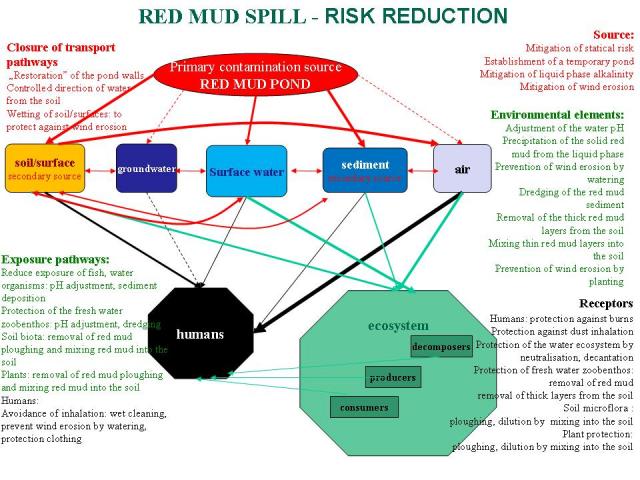What can we do in a red mud impacted area?
The most important is the removal, cancellation, cleaning of the pollution sources. The main pollution source is the red mud pond the dike of which has broken. The broken dike has to be repaired so that the leakage is definetely stopped and if possible the pond to be used again.
In case the breach of the dike cannot be repaired, a new storage pond would need to be established in order to accomodate the red mud collected during cleanup of the areas after the spill. It is not a good solution to discharge the red mud into the surface water system, because the red mud settled in the river bed behaves as secondary pollution source. Therefore the settled red mud has to be removed as it is a secondary pollution source.
The red mud settled on various surfaces, streets, gardens, public areas should be removed and collected in temporary storage facilites. The collected red mud should be kept wet till completion of clean-up in order to prevent delivery of the red mud particles by wind.
The pH of the liquid phase was adjusted by calcium sulphate, meaning it was reduced to almost 9 and the slurry was settled in a storage area surrounded by temporary dikes. Calcium sulphate mixed with red mud results soild precipitate in the river bed. The solid precipitate has to be removed as soon as possible and disposed in the temporary of final storage facility.
Due to the large extent of the affected area it is not possible to remove all the red mud settled on the soil. The low lying areas have to be spotted to delineate the accumulated thick layers of red mud. The material concentrated in thick layers shall be removed and transported to the storage facility. The liquid phase waste should be transported and stored in isolates reservoirs (the same as used fot the storage of red-mud), the solid phase waste, containing soil and red-mud together can be dumped in heaps or prisms with proper isolation.
It is recomended that the rest of the soil contaminated by red mud to be ploughed and mixed into deeper levels of the soil profile. If possible the surface has to be covered by vegetation or seeded to prevent erosion and transport of the particles of the residual red mud by the wind.
Crop on the flooded soil, depending on its contamination should be incinerated or is not contaminated mybe utilised for alcohol-fermentation in specialised biotechnology plants, where starch is converted into alcohol.
Direct contact with the alkaline mud should be reduced to minimum, in case of skin contact to flush immediately. De-watered residue can cause irritation to eyes. The exposed eyes should be flushed with water or by the diluted solution of boric acid. Animals, machines, clothing splashed with alkaline red mud shall be thoroughly flushed and washed and the alkalinity neutralised.
